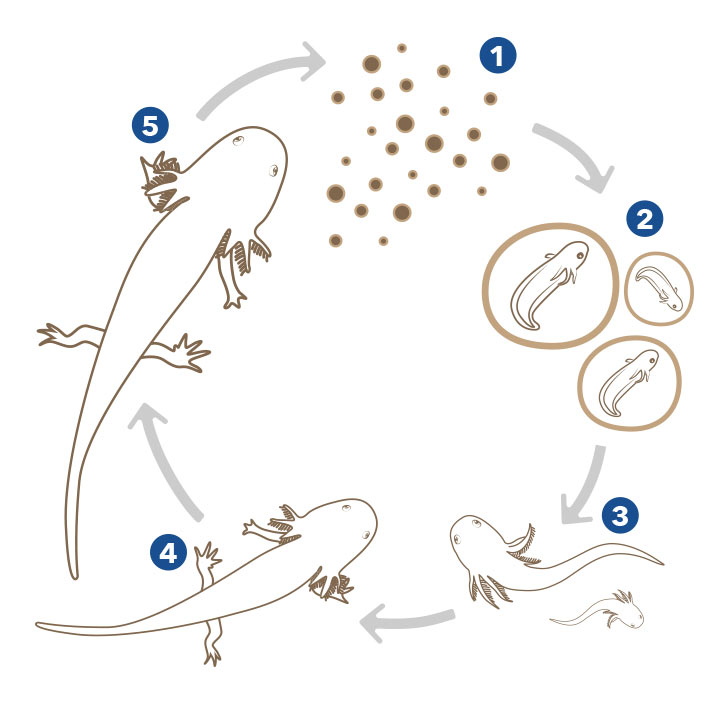Axolotls Ambystoma mexicanum are freshwater amphibians in the Ambystomatidae family. They are known for their unique look. Due to the fact they lack a thyroid stimulating hormone, they do not undergo metamorphosis, so they retain their larval look throughout the course of their lives. When fully mature, they grow most usually to nine or ten inches in length. Nocturnal amphibians, they have been known to live up to ten years, most likely because they have the ability to regenerate many body parts including limbs and tails, as well as organs such as their central nervous system, tissues of the eye, heart, and parts of their brains. This ability to regenerate makes the Axolotl a popular study subject among the scientific community, which uses them to conduct studies on human cancer and other diseases.
Found naturally in two Mexico City lakes, wild Axolotls are listed as critically endangered by the IUCN because one of the lakes was drained and no longer exists. In addition, some are harvested for use in the scientific community and for the aquarium trade. Specimen offered by LiveAquaria® are grown in our own Rhinelander, WI facility. Named by Aztec Indigenous people, their name comes from combining two words: ‘atl’ meaning ‘water’ and ‘xototl’ meaning ‘dog’.
What do Axolotls look like?
Adding to their unique look is the fact that they have wide heads and small black eyes (albino Axolotls have red or clear eyes). With an absence of eyelids, their eyes are always open. Also, their gills are not aligned on their bodies like fish gills, instead they protrude from their head and have tiny filaments on them.
In nature, Axolotl colors most usually are a brownish tan color with an olive undertone and gold speckles. Captive bred specimen can be found in a variety of colors including gold, black/dark blue, pale pink, and gray. Bodies of the Albino Axolotl lack pigment and are white in color.
There are color morphs found in Axolotls. Variations may include:
- Copper morph, where they present in orange hues with bright red gills
- Black morph, with black skin and dark gills
- Leucistic morph, where the Axolotl has albino coloring with pinkish-white skin and bright red gills.
Some Axolotls have an additional quality: a Green Fluorescent Protein (GFP). These axolotls have a slight green appearance that glows under UV lighting.
What type of behavior do Axolotl’s exhibit?
Axolotls have an easy-care level, allow aquarists of varying degrees of experience the ability to keep these peaceful amphibians.
Are there special handling requirements for Axolotls to keep them healthy?
Axolotls need cooler water in which to live, ranging from 61-64 °F. Warmer temperatures in the mid 70°s can cause stress making them more susceptible to infections and disease which could result in death. The level of pH should fall between 7.4-7.6, with KH levels of 3-8. Aquarists should select an aquarium of at least 20 gallons for one specimen. Because they spend a majority of their time at the tank bottom, special care should be taken when selecting the tank substrate. Gravel should not be used; the substrate should consist of smooth sand with grain particles under 1 mm. Bowel obstructions are a common cause of death so care should also be taken that no substrate or décor smaller than 3 cm be allowed within their reach. It is recommended to keep Axolotls in a species-only aquarium.
Because their skin is permeable and their bodies are made of cartilage and not bone, regular testing for proper water parameters is important. Proper care taken in setting up the aquarium will help avoid problems later on like bacterial or fungal infections that poor water quality can bring on, or gravel that gets stuck in their digestive system. Despite the fact they have legs, Axolotls need to stay in water.
What is the Life Cycle of an Axolotl?

- Adult female lays eggs in the water.
- Unhatched offspring develop inside of the egg.
- Larvae hatches from egg.
- Forelimbs and hindlimbs develop.
- Axolotl is now in adult stage and able to reproduce.
What do Axolotl’s Eat?
An unusual carnivore because they don’t have teeth, this member of the Ambystomatidae family sucks or vacuums their food into their stomachs. In the wild, Axolotls enjoy small fish, insect larvae, mollusks, worms, and crustaceans. In captivity, they will eat a variety of readily available foods, including appropriately sized soft pellets, frozen or live bloodworms, earthworms, and waxworms. Adults can be fed 2-3 times per week, juveniles 1-2 times per day. Because of their poor eyesight, they will rely on their sense of smell to locate food. Axolotls can bite, but with the absence of teeth, their bites do not hurt.
If you are ready to start a species-only aquarium that houses one of the most intriguing amphibians the aquarium industry has to offer, consider Axolotls. It is a decision you will get a lot of satisfaction from, your family and friends will marvel at, and you won’t regret.